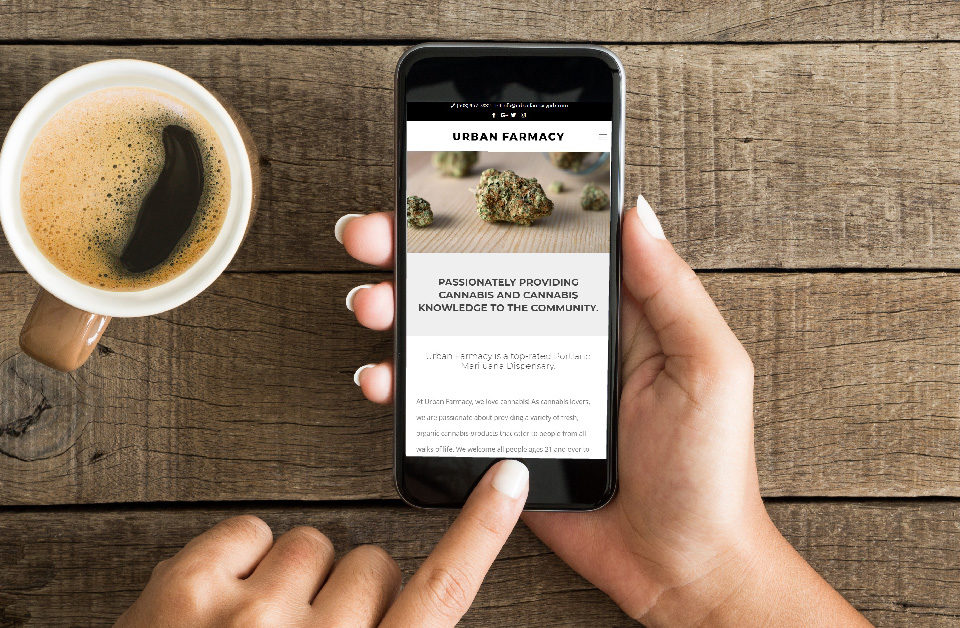- Every Journey Needs A Guide
- (971) 865-5158
Marijuana Website Design Basics

Farma – White Paper
February 20, 2019
CBD SEO Case Study
February 21, 2019What are the basics
of cannabis website design?
MMJ sites, 420 accessory sites, and yes, dispensary and farm sites follow the same basic concepts. Where they arrive can be radically different, and the final design all depends on the skill set of the marijuana website designer. A good cannabis website design firm will follow the basic tenets of design, so as a client, how can you prepare yourself so you have the best experience?
beautifully designed
simple
and plain
Web Design starts with your Brand
It can be hard to accept, but you can’t put the cart before the horse. Websites are designed around the cannabusiness having them built, and when it comes to any industry including cannabis, it starts with the logo. Your logo is the very identity of your brand-it goes on stationary, business cards, reports, ads, and the front of your physical stores.
Marrying the different elements of your brand is known as brand cohesion, and it’s a very important part of your brand identity.
Because a logo is at the forefront of your brand it impacts so much. Many elements of your site design are carried over from, or made to accentuate, your logo.
What carries over from your company logo to your website design?
Cannabis site color schemes: This is one of the primary elements that cannot be decided on without a finished logo. You’ll be presented with a variety of scheme options, but the most typical include complementary colors, contrasting colors, and hue variations on your primary colors.
Shapes and imagery: The best cannabis websites carry elements from their logo into other aspects of their website. That includes angles, patterns, and shapes found within the logo. These can be re-purposed and integrated into backgrounds, buttons, and picture frames.
Fonts: Unique fonts are common in cannabis logos. Just look at some of the clients in our portfolio.
Those fonts are frequently used to create additional on-page elements. The homepage for Smoking Crow dispensary is a great example of this practice at work. Logo typefaces may also be re-used as header fonts as well.
What else will you need
for your marijuana web design?
Start taking pictures as soon as you decide you want a website. It’s difficult to count the number of projects that have been held up by photography. Designers frequently use client-taken photos on a website, and though professional photography is best, if you have a staff member who’s taken an intro-to-photography class at some time in their life, do yourself a favor and let them take pictures.
You’ll need:
- Images of your storefront including signage.
- Images of your dispensary interior and product counters.
- Images of your cannabis/hemp/cbd fields. For those in cannabis cultivation, consider images with farm animals, barns, or other traditional elements that say, “We’re a family-owned and operated business.”
- Images of staff.
- Images of a happy customers interacting with staff.
Start collecting sample sites you like as soon as you can.
switch devices
stop engaging
Everyone has a preference, and chances are you decided on a new website once you started seriously looking at the competition. Samples of what you like are a gold mine for a developer, and can help inspire and direct their work. Separating the samples can also help. Consider the following site elements and find examples you like, these elements also make up the core aesthetic of your website.
Menu layouts and navigation aids: If you have trouble navigating a website, it’s a bad example. Focus specifically on how easy it is for you to find the information you’re looking for. Look at the homepage layout, what you see above the fold, side menus, and the main menu at the top of the site.
Site layouts and aesthetics: Look at how the site is laid out and find the individual elements you’d like to incorporate into your own website. Do you like the transition shape in a background section between two pieces of content? Is there a banner image that evokes a certain feeling you want to bring out in your own site visitors?
What does a good site designer handle for you?
Now you aren’t expected to put all of these things together if you don’t want to. Your site design firm will help you with scheduling, and it almost always starts with an idea board to get a sense of what you’re looking for and what you like.
Trust your designer for:
Specific site layout decisions. There are multiple studies that show where a site users attention goes to first. Examples include website users reading in an F pattern and giving more attention to the left side of the screen. A well-versed designer knows consumer habits and adjusts your site to meet them.
Banner and above-the-fold recommendations. Did you know 80% of users never wait to see a second banner image? It can be easy to make choices that hurt your site because they look neat, but trust the data. Your developer should know how important the first thing your customer sees is, and what to do with the space to maximize it.
Optimization suggestions. If it has to do with optimization, listen to your developer if they also provide SEO (and have previous examples that show their success). Nothing hurts usability more than a slow site, images that don’t load, or stuttering videos. These things will cost you customers and those customers will not be back.
What do website users
like least about a website?
The best cannabis websites are built for the user. A comprehensive study presented at the 2004 Conference on Human Factors in Computing Systems in Vienna, Austria found that 94% of users cited the following design flaws as their biggest reasons for mistrusting or rejecting a website during a first impression:
- An overly complex or busy layout
- A lack of navigation aids
- Boring website design and specifically dull use of color
- Pop-up advertisements
- Slow introduction to the website
- Illegible print or too much text
- Sites with a corporate look and feel
- Difficulty searching a website
Build off of what you’ve learned, and you should be able to start your new web build or redesign on the right footing. If you do, you can make incremental improvements that deliver long-term growth and increase customer retention.



